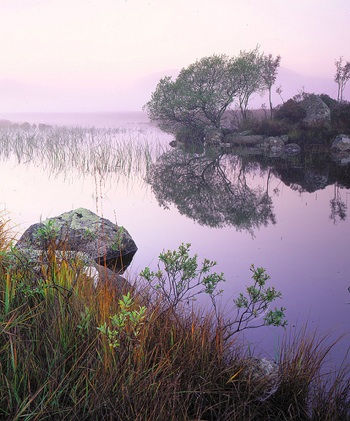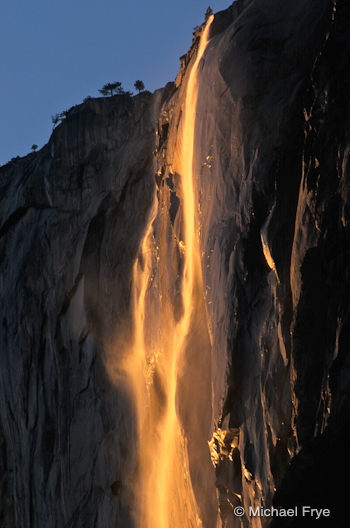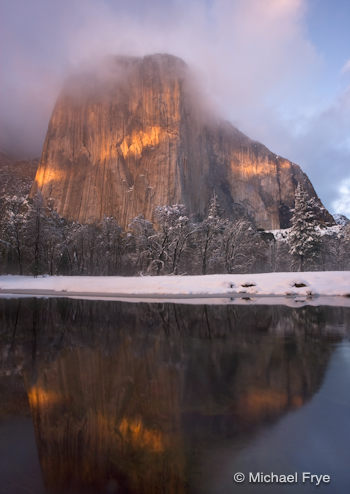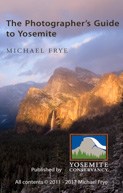by Michael Frye | Feb 1, 2010 | Yosemite Photo Conditions
It’s February, so Horsetail Fall season has nearly arrived. Herds of photographers will soon be standing tripod-to-tripod hoping to catch that magical neon glow on this ephemeral slice of water.
Conditions have to be just right to capture a classic Horsetail Fall image: Sufficient water has to be flowing, and the skies need to be clear in the west to allow the setting sun to light the waterfall. It looks like the first condition will be met, as there’s plenty of snow on top of El Capitan to feed Horsetail. How clear the skies will be is anybody’s guess at this point. The ideal scenario would be a stretch of warm clear days during the peak window of light, but that seems unlikely in this El Niño winter.
About that peak window: I posted an article on my website last year describing how I used the Yosemite Association’s web cam to determine the optimum window of light for Horsetail Fall. My conclusion was that the peak day occurred about 60 days after the winter solstice, with the best light stretching from about seven days before that to three days after that. I’ve since learned that the earth wobbles a bit in its orbit, so the sun doesn’t set at exactly the same angle 60 days before the solstice as it does 60 days after the solstice. So I now use the angle — the azimuth — of the setting sun as the best way of determining when the peak day will be. This year February 18th comes closest to the ideal angle, with the window of best light stretching from about February 11th through February 21st.
There are basically two good spots to photograph Horsetail: near the El Capitan picnic area along Northside Drive, and along Southside Drive about .8 miles east of the Cathedral Beach picnic area. I prefer being near the El Capitan picnic area, but both locations have their virtues.
Many people have asked me if I’ll be doing one-day Horsetail Fall workshops again this year with The Ansel Adams Gallery, but I’ll be attending the North American Nature Photography Association’s (NANPA) Summit in Reno from February 16-19, so I’ll miss most of the Horsetail Fall craziness. The Gallery will be hosting a couple of afternoon photo classes with their staff photographers during that time, and if conditions are right they will lead their groups to good spots for Horsetail Fall.
Even though I might miss out, I hope we get some clear sunsets between February 11th and 21st, as that would make many other photographers happy! Good luck to all of you with Horsetail aspirations this year.
by Michael Frye | Jan 27, 2010 | Critiques

Thanks to everyone who submitted photographs for this critique. 26 people uploaded images to Flickr, and there are some outstanding images in the collection. I had to pass over a lot of interesting choices, but I’m keeping several in mind for future critiques.
I chose this image mostly for aesthetic and instructive reasons, but also because the international flavor appealed to me. The photographer, Tim Parkin, lives in Leeds, UK, and the photograph was made at Lochan Na h’Achlaise (which Tim says roughly translates as ‘Loch of the armpit’) in Rannoch Moor, Scotland. Also, I like the title Tim used on Flickr—“That Damed Loch”—although his official title isPinks, Lochan Na h’Achlaise, Rannoch Moor.
I love the soft, subtle, color palette of this photograph, with pinks, golds, and hints of green. Many photographers would be tempted to pump up the saturation, but I think that would make this image look garish and fake, and lose some of its attractive, quiet feeling.
The composition is well seen and thought out. The main focal point is the shrub on the island just right of center, and my eye moves from that down to the smaller shrub, grasses, and rocks in the foreground. Tim was careful to keep separation between everything in the foreground and the reflections in the water, with the exception of the unavoidable merger between the three tall grasses just left of center and the reeds behind them.
The small foreground shrub echoes the shape of the larger one in the background, adding some repetition and tying the foreground and background together. I often see random foregrounds that seem stuck on, included only because the photographer felt that a foreground was obligatory. If you’re going to include a foreground it has add something to the image and tie in with the background somehow, either with similar lines and shapes, or by leading the viewer’s eye into the distance. Here the foreground definitely adds interest, and echoes shapes in the background. (more…)
by Michael Frye | Jan 25, 2010 | Yosemite Photo Conditions
Sunbeams on El Capitan Saturday evening
Our workshop group had an adventure last week. It snowed off and on (mostly on) from Monday through Friday morning. The power went out Wednesday afternoon, so we did print critiques in the Ahwahnee Hotel’s Winter Club Room. The temperature hovered just around freezing in Yosemite Valley most of the week, so the snow melted during lulls in the precipitation, and by Thursday afternoon there were only about six inches on the ground. But that night the temperature dropped, and Friday morning I measured 16 inches on the railing outside The Ansel Adams Gallery.
A week of heavy, wet snow was apparently too much for many trees and limbs, and during the night Thursday and all day Friday the valley was filled with the sound of cracking, falling branches. Out in Cook’s Meadow Friday morning we could hear and often see limbs or whole trees falling every few minutes. The National Park Service had to close all the roads because they couldn’t keep up with the tree removal; they’d no sooner clear a stretch of roadway when another tree would fall across it. They issued warnings telling everyone to stay inside. Several of my workshop students were evacuated from their rooms at Yosemite Lodge because of dangerous limbs, but luckily there were other rooms available in safer buildings.
My workshop students endured all this without complaint—in fact they were excited to see Yosemite covered in snow. We found ourselves trapped in the east end of Yosemite Valley Friday, but no one minded because it was beautiful. The cliffs and trees—the ones that were still standing—were decked in white, and the sun broke through briefly in the morning. We just had to avoid walking under branches!
The roads reopened Saturday morning, after a closure of more than 24 hours. Saturday afternoon the skies cleared, and we saw so
by Michael Frye | Jan 15, 2010 | Critiques
I’m starting a new feature in this blog: a weekly photo critique. Every Tuesday or Wednesday I’ll pick a photograph submitted by one of my readers, write a detailed critique, and invite other readers to post their comments as well.
I’ve always felt that portfolio reviews are one of the most valuable parts of my workshops—perhaps the single best teaching tool. Everyone gains insights into their photography, regardless of who’s work is being reviewed. This new blog feature give you the chance to have one of your photos critiqued for free. But more importantly, I hope every reader will learn something.
I’ll post the first critique on January 26th or 27th. If you want your images considered for a critique, post it to the Flickr group I’ve created for this purpose. (You’ll have to join Flickr, but it’s free and easy). Photographs will be chosen for their instructive value, not necessarily their quality. Please, no more than five images per person per week!
by Michael Frye | Jan 13, 2010 | Announcements
Rising Moon, Gates of the Valley
I’ve just launched another blog called 25 Years in Yosemite: A Photographer’s Journal. While this blog is written for landscape photographers, the new blog is for anyone interested in Yosemite. Each week I’ll post a short essay telling the story behind a photo, talking about the park’s natural history, or relating a personal experience from living in or near Yosemite for over 25 years. I’ll take readers through an entire year in the park, following the seasonal changes as they happen. Learn the story behind this photograph in the latest post.












